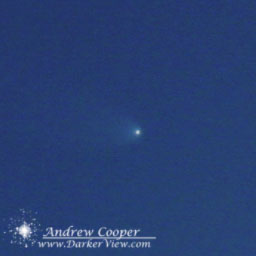C/2006 P1 McNaught is currently passing close to the Sun. At a mere 18 million miles (0.197 AU) from the Sun the intense solar radiation is causing the comet to boil and vent violently. The resulting cloud of gas and dust is reflecting enough sunlight to brighten the comet dramatically. Estimates are placing the comet at mag. -5 or even mag. -6. This is much brighter than even Venus! Some observers are reporting easy unaided eye visibility, but in the sky over Tucson a lot of dust and aerosols in the air are causing a great deal of glare around the Sun. Thus binoculars or a telescope is required to see the comet.

The view was better in the eyepiece. A sharp point of the coma with a fan shaped tail. This really looks like a classic comet, I had not expected such a good tail in the bright sunlit sky. This is my first daytime comet, and since the opportunity may not come again anytime soon, this may be my only chance to see one, truly a once in a lifetime event!
